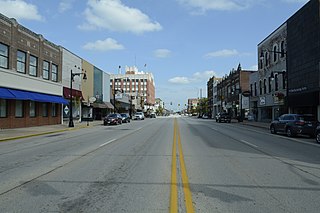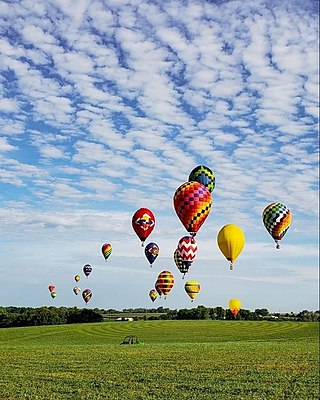
Galesburg is a city in Knox County, Illinois, United States. The city is 45 miles (72 km) northwest of Peoria. At the 2010 census, its population was 32,195. It is the county seat of Knox County and the principal city of the Galesburg Micropolitan Statistical Area, which includes all of Knox and Warren counties.

Indianola is a city in Warren County, Iowa, United States, located 14 miles (23 km) south of downtown Des Moines. The population was 15,833 at the time of the 2020 census. It is the county seat of Warren County. Indianola is home to the National Balloon Classic, a nine-day hot air balloon festival held annually in the summer, the Des Moines Metro Opera, a world renowned major American Summer Opera Festival, and Simpson College.

The Chicago, Burlington and Quincy Railroad was a railroad that operated in the Midwestern United States. Commonly referred to as the Burlington Route, the Burlington, or as the Q, it operated extensive trackage in the states of Colorado, Illinois, Iowa, Missouri, Nebraska, Wisconsin, Wyoming, and also in Texas through subsidiaries Colorado and Southern Railway, Fort Worth and Denver Railway, and Burlington-Rock Island Railroad. Its primary connections included Chicago, Minneapolis–Saint Paul, St. Louis, Kansas City, and Denver. Because of this extensive trackage in the midwest and mountain states, the railroad used the advertising slogans "Everywhere West", "Way of the Zephyrs", and "The Way West".

The American Royal Zephyr was a streamlined passenger train service operated by the Chicago, Burlington and Quincy Railroad between Chicago and Kansas City. This CB&Q Zephyr was named for the American Royal, one of the Midwest's largest and oldest livestock exhibition, professional rodeo, and horse show.

The Nebraska Zephyr was a streamlined passenger train operated by the Chicago, Burlington and Quincy Railroad between Chicago, Illinois; Omaha, Nebraska; and Lincoln, Nebraska, from 1947 to 1971. Until 1968, the service was provided by two Twin Cities Zephyr articulated trainsets — the "Train of the Gods" and "Train of the Goddesses" — that became synonymous with it. The Nebraska Zephyr was one of many trains discontinued when Amtrak began operations in 1971. The "Train of the Goddesses" set is preserved at the Illinois Railway Museum in Union, Illinois.

The Black Hills Central Railroad is a heritage railroad that operates in Keystone, South Dakota, United States. The railroad was added to the National Register of Historic Places on February 5, 2003.

The Kansas City Zephyr was a streamliner passenger train service operated by the Chicago, Burlington and Quincy Railroad (CB&Q) between Chicago and Kansas City.

TheNational Museum of Transportation (TNMOT) is a private, 42-acre transportation museum in the Kirkwood suburb of St. Louis, Missouri. Founded in 1944, it restores, preserves, and displays a wide variety of vehicles spanning 15 decades of American history: cars, boats, aircraft, and in particular, locomotives and railroad equipment from around the United States. The museum is also home to a research library of transportation-related memorabilia and documents.

Galesburg is an Amtrak intercity train station in Galesburg, Illinois, United States. The station was originally built in 1984, after the razing of the large depot just south of the current site. It is located north of the large BNSF Classification yard. Just south the Illinois Zephyr and Carl Sandburg diverge via the Quincy main line which bypasses the yard on the east side. The California Zephyr and the Southwest Chief continue to the southwest side of Galesburg near Knox College.

The Great Plains Transportation Museum is a railroad museum in Wichita, Kansas, United States.
The Omaha and Council Bluffs Railway and Bridge Company, known as O&CB, was incorporated in 1886 in order to connect Omaha, Nebraska with Council Bluffs, Iowa over the Missouri River. With a sanctioned monopoly over streetcar service in the two cities, the O&CB was among the earliest major electric street railway systems in the nation, and was one of the last streetcar operators in the U.S., making its last run in 1955.

The Chicago and Aurora Railroad was a direct predecessor of the Chicago, Burlington and Quincy Railroad. Its original incorporation as the Aurora Branch Railroad, chartered in February 1849, started as a twelve-mile branch line which Class I giant BNSF cites as the beginning of their empire: this “short stretch of track set BNSF’s destiny into ‘loco-motion’ and grew over many decades into a network spanning 32,500 miles.” Beginning in 1853, as the Chicago and Aurora Railroad, the company's tracks eventually extended from Chicago to Mendota via Aurora, Illinois, also creating what would become the oldest commuter line in the Chicago area.

Galesburg Santa Fe Station was a railway station in the west central Illinois town of Galesburg. The station was along the Atchison, Topeka and Santa Fe Railway's main line and served trains such as the Super Chief and El Captain. After Amtrak took over intercity rail in the United States, it was served by trains such as the Lone Star (1971–1979) and the Southwest Chief (1971–1996).
Catharine, formerly known as Burgess Junction, is an unincorporated community in Serena Township, LaSalle County, Illinois, United States. Catharine is located along County Route 2, 2 miles (3.2 km) west of Sheridan. Burgess Junction was named for a Chicago, Burlington and Quincy Railroad attorney. Its name was changed to Catharine in 1968 by the CB&Q at the request of Ellis Waller who proposed to Catharine (Katie) Bentley there on May 23, 1968 during a fund raising railroad excursion that Ellis had arranged.
The Cameron connector is a section of track built in 1995–1996 which connects the former Burlington Northern Railroad and the former Atchison, Topeka and Santa Fe Railway tracks, both which are now part of the BNSF Railway, to each other near Cameron, Illinois.

Grand Canyon Railway 4960 is a preserved O-1A class 2-8-2 "Mikado" type steam locomotive built in August 1923 by the Baldwin Locomotive Works for the Chicago, Burlington and Quincy (CB&Q) Railroad. It was used by the CB&Q to pull freight trains, until 1958, when the locomotive pulled its first excursion fantrip, as part of the railroad's steam excursion program.

The Chicago Burlington and Quincy O-5 was a class of 36 4-8-4 "Northern" type steam locomotives built by the Baldwin Locomotive Works in 1930 and the Chicago, Burlington and Quincy Railroad (CB&Q) between 1936 and 1940 and operated by the CB&Q until the late 1950s.

Chicago, Burlington and Quincy No. 4000, also known as Aeolus, is a preserved S-4a class 4-6-4 "Hudson" steam locomotive that was originally built by Baldwin in 1930 as S-4 locomotive No. 3002. It was primarily used to pull fast passenger trains before it was rebuilt by the Chicago, Burlington and Quincy Railroad in 1937 to be re-classified as an S-4a with Streamlining, and it was renumbered 4000 in the process. The streamlining was removed during World War II, and the locomotive was later downgraded to secondary passenger and mail service. In 1956, No. 4000 pulled two excursion trains out of Chicago, Illinois before it was retired. The locomotive was donated to the city of La Crosse, Wisconsin in 1963, and it remains on static display in Copeland Park, as of 2024.

Chicago, Burlington and Quincy 5632 was an O-5B class 4-8-4 “Northern” built in the CB&Q's shops in August 1940. It was used to pull mainline passenger and freight trains before it eventually became famous for pulling a plethora of excursion trains for the CB&Q's steam excursion program. By the time the program ended in 1966, No. 5632 was disassembled for an unfinished overhaul, and was subsequently sold to Chicago area railfan Richard Jensen.

Chicago, Burlington and Quincy 4963 is a preserved class "O-1a" 2-8-2 "Mikado" type steam locomotive originally built by the Baldwin Locomotive Works in 1923 for the Chicago, Burlington and Quincy Railroad. It was used by the CB&Q to haul mainline freight trains before it was leased to the Bevier and Southern Railroad to haul short-distance freight trains in the early 1960s. It was subsequently retained by the CB&Q and used as a source of spare parts before being acquired by Richard Jensen.

















